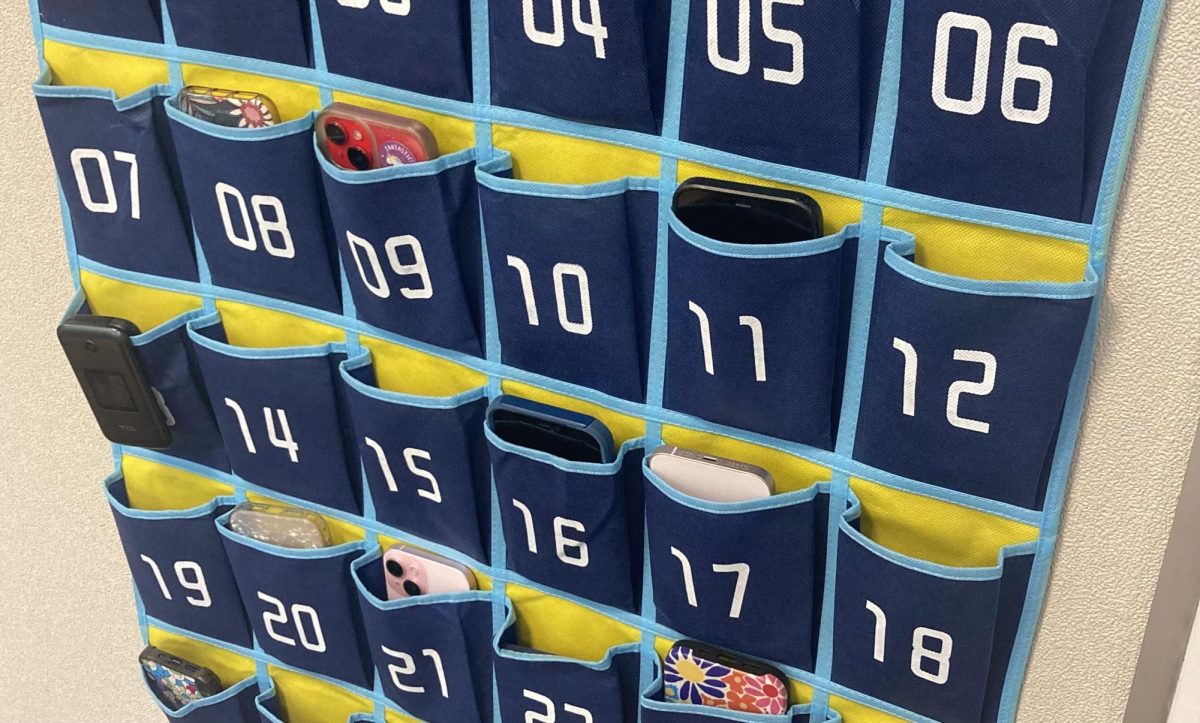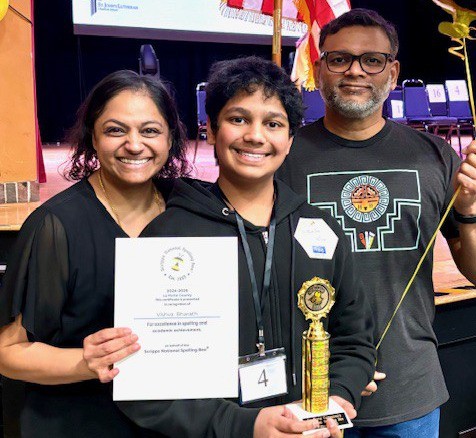The Banning of Cell Phones
The first and likely most notable policy is the restriction on cell phones. Over the summer, Indiana Legislators banned phones, personal laptops, and smartwatches in classrooms across Indiana.
“The teachers have always had a policy in their classrooms. It’s just a little more strict now,” commented junior Claire Vrahoretis.
In the past, it’s been up to the individual teachers whether or not phones should be allowed. This year though, it’s a universal law.
“It takes the pressure off of me as the teacher, because I’m just the messenger,” explained Ms. Orosz, a French teacher and girls’ soccer coach.
Variation and potential unfairness are now out of the equation, leaving one rule for everyone to follow. And while teachers were concerned about fighting the phone battle, it turns out they had nothing to worry about.
“I think students have adapted to the new cell phone policy especially well…There’s been very little student pushback,” noted Mr. DeRuntz, history teacher and Quiz Bowl sponsor. Although the policy is a significant change, it hasn’t taken CHS very long to get used to it. And already, Chesterton teachers are reaping the benefits. “My students are far more focused because they don’t have the temptation of distraction,” DeRuntz continued, “they’re leaving class with less work to do because they’re getting it done in class.”
Cell phones often absorb valuable work time. Not only is this new rule encouraging productivity, but it’s also promoting community. Ms. Orosz has noticed that her students are more conversational and less anxious about saying things in French. This law isn’t without consequences, though. Duneland also banned airpods and earbuds, with exceptions for students with a 504 or an IEP.
“I think the bad thing is SRT. Using music or podcasts helps a lot of people focus, and you’re not allowed to have any kind of earbuds out,” stated senior Lilly Demmon. Music can be a great tool to help students focus on homework and stay ‘in the zone.’ Without them, many students are left without an essential part of their normal study habits. While some classes may be better off without distractions, there are exceptions that the new policy doesn’t address.
Bell Schedule Overhaul
Another significant change to Chesterton High School this year is the new start time and end times. Until this new schedule was devised, the former schedule had been in place for more than twenty years. This year, CHS changed to start 30 minutes later, at 8:10, and school now goes to 3:10. This new schedule has benefited high schoolers.
“It actually gives me more sleep,” said sophomore Mady Clark. The new start time aligns better with the average teenage sleep schedule than the past one did.
“Data shows, science shows that, just physiologically, for the teenage mind, starting later is better,” explained Mr. DeRuntz.
The new schedule allows students to add more time to their morning routine. “I haven’t been running late, really,” Demmon shared, “I have enough time to get here and get to class. That’s been something new for me.”
While the new schedule makes morning routines easier, it’s had some consequences for student athletes.
“Sports still go to the same times, so you’re more rushed to practice,” said senior Milena Letic, who plays for the girls’ soccer and lacrosse teams. Athletes might have less time to acclimate before practice. Overall, the bell schedule works out in a lot of ways, but, being branch new, it’s not entirely without complications.
Attendance Policy Changes
This year, CHS also introduced a more detailed attendance policy. Normal absences, like note-verified doctor/dentist appointments and college visits, are excused just like before. Now, students have up to 4 absences per semester that a parent can call in without a note. After that, though, you’re considered truant. This new policy is in response to the huge uptick in student absences last year.
“I think it was just really easy to manipulate before, and students were gone maybe more than they had to be,” commented DeRuntz.
It’s excessive truancy that the school is worried about, and that’s what the policy is trying to prevent.
“People who abuse it are the ones who should be cracked down on, so it makes sense,” Letic stated.
And she’s right. This policy isn’t aimed at students who miss a couple of days a semester, or who have to miss school for medical or family reasons. It’s aimed at the students who miss school simply because they want to.
“Honestly, as a teacher, having students in the desks makes my job easier,” DeRuntz shared, “It’s less work for me, playing catch-up with students who have constantly had makeup work to do.”
Students’ attendance records are extremely important. Our district’s attendance is tied to our reputation and even our funding from the state. Having students here, physically at school, will help both the individual and the collective. This new policy hopes to improve that.
Parking Rules Tighten Up
CHS has also decided to crack down on parking passes this year. All student drivers must purchase a parking pass and display it visibly to park at Chesterton High School. These rules aren’t new to this school, though.
“They’ve been that way forever. We’re just trying to enforce them now,” said Sergeant Swickard, resident School Resource Officer. While the passes may seem trivial, there are actually a lot of good reasons why you should get one.
“The parking passes are free… so it’s really nothing,” responded Vrahoretis. There’s no fee: just some quick paperwork, which you can pick up at the main office and fill out within a matter of minutes. Second, the passes help identify students if they’re part of a collision.
“Let’s say someone sideswipes your car. We can figure out who was parked next to you. You say, ‘Hey, it was parking pass, say, 324.’ I can look that up and see who it is,” explained Swickard.
These passes can be extremely helpful in situations where you might need a car identified. This year, the passes are much smaller and can easily be attached to your rearview mirror. You can pick up a student parking application in the main office. The due date for those applications was last Wednesday, so if you don’t already have a pass, grab one!
New Levels of AI Use
Last year, the DSC assembled a small AI committee to form the policies surrounding this new phenomenon. This year, those policies are in place and ready for teachers to use at their discretion.
“Part of our responsibility is to prepare you for life after high school, and life after high school is going to involve AI,” explained Mrs. Wilt, Director of the Media Center, who was part of that committee.
They designated different levels of AI usage. Level 0, for example, is no AI use at all. Level 2 is AI-assisted editing, and level 4 is full AI use, with human oversight. A lot of teachers have had issues with cheating, and therefore avoid AI altogether. But there’s a plethora of ways that AI can be used in a classroom setting without crossing the line. “You could assign an essay and make students use AI to write it. And then in class, work together, pick apart what the AI did correctly and incorrectly,” suggested Wilt.
That would teach students to use a powerful tool while simultaneously showing them the drawbacks of fully relying on it. Generative AI can also be used to get past writer’s block or presentation block. In addition to teaching students how to navigate the future of this new technology, the policy has helped teachers. AI can assist teachers with class organization or generating new test questions. However, there are some things to keep in mind.
“One thing that’s super important to realize is any tech tool is only as good as the people who built it,” noted Mrs. Wilt, “Depending on which data set a generative AI tool has been trained on… it could give you really biased stuff.”
AI is an extremely useful and versatile tool. It can add a lot to a classroom. But at the same time, there are dangers to using it, and these policies seek to minimize those negative effects while acclimating both students and staff to the new technology.














